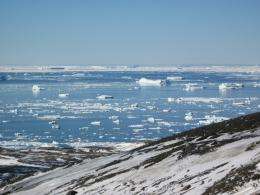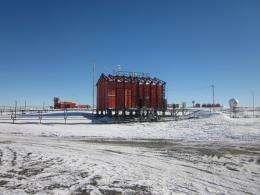Testing spacesuits in Antarctica, part 1

In this field diary, Margarita Marinova takes us on a journey to Antarctica in order to test spacesuits Testing the suits in harsh environments on Earth can help future explorers, who will need protection when investigating Mars and other places in the Solar System.
Once you’ve been to Antarctica, you just really want to go back. There is a sign in the lunch room here at Marambio base, that says (with poetic license thanks to Pablo): “When you arrived you barely knew me; when you leave you’ll take a part of me with you.” There is something about Antarctica that always stays with you and beckons you back. So how could I possibly say no to going down to Antarctica for a second time in the same season?
The goal of the project is to test a prototype pressurized Mars spacesuit. The Antarctic provides a relevant environment for collecting samples and doing science – just the way we would on Mars. We will be testing both using the spacesuit in a Mars analogue environment and doing new science.
Marambio Island (also known as Seymore Island) is near the tip of the Palmer Peninsula, at S64° 14’ W56° 43’. We were invited by the Argentine Air Force to test the space suit at their Marambio Base in Antarctica – an incredibly gracious offer, and an incredible amount of support from them!
Marambio Island has provided an interesting site for finding old fossils, and is a long-established Argentine base. In summer they have up to about 150 people here, and the crew that winters over is about 50 people. In summer (Dec-March) flights from Argentina are frequent – every few days. In the winter the flights are every month. This is unlike places like McMurdo, which are farther south and aircraft cannot land there in winter.
The Marambio base also serves as the center of helicopter activity for many of the surrounding bases. The large C-130 aircraft can land here, but helicopters are needed to go to the other Argentine bases, as well as the UK and Chile bases, and to the field sites where the scientists want to work.
The spacesuit we are testing is a fully pressurized suit which is being developed for future planetary exploration. Testing it in a Mars-relevant environment allows us to really optimize it for the types of activities we will be doing on Mars.
March 8, 2011
San Francisco – Washington Dulles – Buenos Aires – Rio Gallegos – Marambio, Antarctica in 50hrs. Maybe.
Every good trip starts with an early morning ride to the airport. With our 6 large cases of equipment and warm clothing, Jon Rask and I headed to San Francisco airport, just north of NASA Ames Research Center where we are based. With us was the spacesuit that we will be testing on this trip. It’s a prototype pressurized Mars spacesuit, and we’ll be seeing how it works in a Mars analogue environment doing the type of work we expect to be doing on Mars.
As we got to the airline counter, with our huge stack of bags, Jon pulled out his NASA badge and said: “So we are with NASA, and are testing a spacesuit in Antarctica. Does the spacesuit get to check in for free?” The lady behind the counter smiled widely and replied “Let’s see what we can do.” I was tempted to just put on the spacesuit and wear it into the plane, but I guess this time around it would travel in the cargo hold.

Amazingly enough, Jon and I arrived in Buenos Aires with all 6 bags! A huge relief! We were greeted by our military escorts, and together with the spacesuit, got to use the speed lane for “Diplomats only.” I guess traveling with a spacesuit does give you some special privileges – I should do it more often! After a few hours of going through immigration and clearing customs, we were out into the great city of Buenos Aires.
The Argentinian Air Force greeted us. As with most Antarctic programs, the country’s military forces coordinate flights to their Antarctic bases. In this case we were also going to catch a flight to Rio Gallegos through the military. Rio Gallegos is a town in the southern tip of Argentina from where the Antarctic flights start.
The original plan had been to go directly from the international airport to the military airport, but we found out that our flight had been delayed by a day. So instead we headed to a restaurant for a nice meal; in Argentina that means large steaks! A few hours later, we checked into the Air Force hotel and I fell asleep exhausted from the trip.
Source: Astrobio.net



















